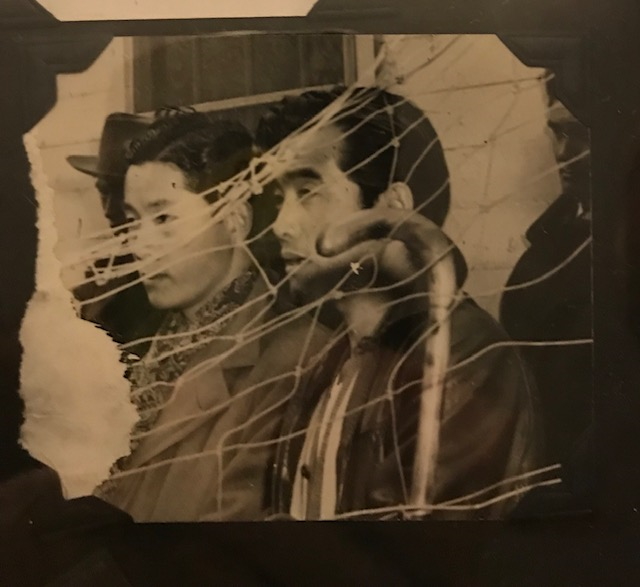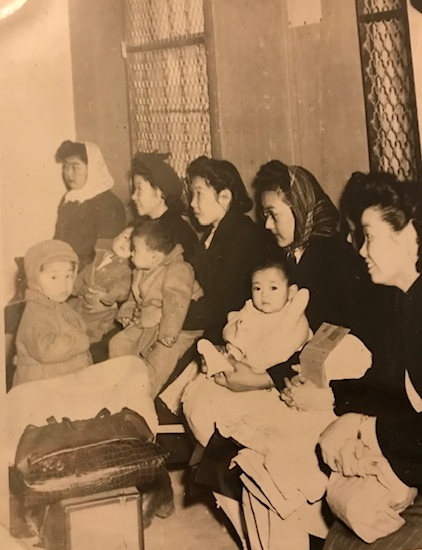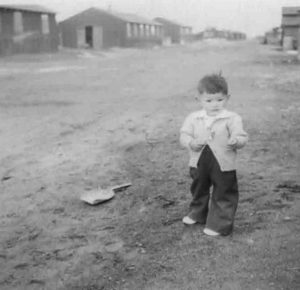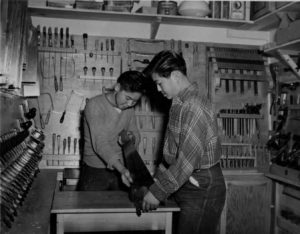BOOKLIFE REVIEW: Affiliated with PUBLISHERS WEEKLY magazine
 Based on a true story, this novel details the horrors of Japanese Internment Camps in the United States through the eyes of a young child. At the tail-end of World War II, twelve-year-old Helen Hannan’s father takes a job as a lawyer with the War Relocation Authority, representing Japanese-Americans who are reentering society after their imprisonment at the hands of the U.S. government. Helen and her siblings are stunned to discover that the camps exist and then horrified by the conditions. Soon, the family is stationed at the Camp Granada War Relocation Center, in Colorado, where Helen is impressed by the resilience and faith of the interned citizens. After the camps close, with the spirit of injustice still in the air, Helen takes it upon herself to document the true conditions of the centers. The result is this lightly fictionalized novel, published nearly 75 years later.
Based on a true story, this novel details the horrors of Japanese Internment Camps in the United States through the eyes of a young child. At the tail-end of World War II, twelve-year-old Helen Hannan’s father takes a job as a lawyer with the War Relocation Authority, representing Japanese-Americans who are reentering society after their imprisonment at the hands of the U.S. government. Helen and her siblings are stunned to discover that the camps exist and then horrified by the conditions. Soon, the family is stationed at the Camp Granada War Relocation Center, in Colorado, where Helen is impressed by the resilience and faith of the interned citizens. After the camps close, with the spirit of injustice still in the air, Helen takes it upon herself to document the true conditions of the centers. The result is this lightly fictionalized novel, published nearly 75 years later.
Aimed at young readers, Two Days and One Suitcase frankly explores disturbing aspects of this history (the lack of privacy in the camps, the mandated communal bathrooms, the government’s stripping of safety and sovereignty from its citizens), Neuberger and Parra don’t delve too deeply into the specific atrocities. The result is successful—age appropriate without shying away from the harsh realities. The authors include some overtly educational elements, with many chapters focused on vocabulary expansion, an introduction that lays out the historical basics, and an appendix.
The story follows a young woman’s observations over a short time period, meaning readers should not expect traditional plot progression, and the lack of a distinct beginning, middle, and end may be discouraging to young readers. There is very little in-depth focus on anyone but Helen and her sister—her father’s work, though interesting, remains in the background. But this is a fast-moving, thoughtful book, one that finds a young woman driven to memorialize a blemish on American history—and offering an education to readers today.
Take away: This true story, following a young woman’s drive to document injustice at a Japanese internment camp, is a staunch reminder to stand up to prejudice.
REVIEWS and AWARDS from the CATHOLIC MEDIA ASSOCIATION
- FIRST PLACE: Self Published
This is a five-star book. Everyone, starting with middle school and high school and on through adulthood, should read this book. The absolute goodness of the Hannan family shines through the book making reading about the interment caps a little less bleak. To know about the terrible injustice of the Japanese internment camps in the United States is to make sure it never happens again.
- FIRST PLACE: Books for ages 11-16
Uniquely designed book and text undertaking an important story of why war breaks our Heavenly Father’s heart. Told in the first person, this narrative is compelling as well informative/instructive.
- FIRST PLACE: Catholic Novels—Education
We need more stories like this. We learn and appreciate history when we read accounts of ordinary people in unbelievable circumstances who do the extraordinary. Timely and inspirational.
- HONORABLE MENTION: Memoir
REVIEW FROM TERI NOMURA, 3rd generation Japanese-American
This unique story, ”Two Days and One Suitcase,” is told from the point of view of 12-year-old Helen, who moves into a Japanese American internment camp with her family during WWII. Helen’s father is a lawyer, a white man, helping the Japanese Americans through their legal problems. Helen Hannan Parra, now in her 80s, co-authors this true story with Anne Neuberger to re-create the setting and all of the questions a young person might have about justice in the USA.
Many people today are not aware of the hostile environment of the internment camps in American deserts. Over 110,000 Japanese-Americans were forced out of their homes, stripped of their livelihoods and possessions and herded into barbed wire wrapped prisons for four years. This story describes the crowded shelters, the barren landscape and the brutal treatment the internees endured. Helen sees the contrast between her family’s comforts and freedom and the deprivations of the Japanese American families.
As a young person witnessing this bizarre injustice, Helen asks important questions, such as: Why did this happen? Did these people do any harm? What will happen to these people once the war ends?
The book is intended for young adults, and like Anne Frank’s ”The Diary of a Young Girl,” we can all learn from the young author’s experience. This story is a stain on American history; a story that history books would like to forget. Education is at the core of making social change. People learn best through story, rather than just facts. This story brings the reality of that social injustice forward. Today’s prejudice against people of different races, religions, ethnicities and sexual preference bring similar questions to light. Why is this happening? What can we do about it?
I appreciate the historical accuracy in this story. My extended Japanese American family told a similar story, with the desert sand infiltrating their quarters and food, and the uncertainty of their future. In particular, Helen’s description of the ‘No No Boys’ who answered ‘No’ to two intentionally confusing questions posed by the government as a loyalty test, matches my family stories.
The questions Helen asks in the book create a springboard for discussion. Readers young and old may question their personal beliefs against the backdrop of this often ignored chapter of American history. Then maybe, just maybe, we will be more able to create a more just world.
Teri Nomura is a sansei, 3rd generation Japanese-American, living in the Pacific Northwest. Her parents and every person of Japanese ancestry that she has ever known were incarcerated during WWII. Some cousins were born in ‘camp’, others died. When the war ended, her mother’s parents were each given $25 and a bus ticket back to their home town. There they discovered that their home was burnt to the ground by the army. Her grandmother killed herself because she did not want to be a burden on her 75-year-old husband. The loss was severe. After WWII the Japanese-Americans worked hard to meld into post-war society.
REVIEW FROM GREGORY DARR, Maryknoll Missioner
A young girl’s notebook becomes a testament to faith and dignity amid injustice.
I was in high school in the late 1970s before I had ever heard of Executive Order 9066 and the unjust imprisonment of over 100,000 Japanese-Americans during World War II, most of them U.S. citizens. Since then, public awareness has grown and several books, a few long ago published, have come to greater recognition in illumining this dark moment in U.S. history.

Most the stories I’ve encountered are intimate ones — the struggles of individuals and families who suddenly found themselves uprooted from homes, farms and businesses in an epoch of war hysteria stoked by nearly a century of racism. “Two Days and One Suitcase” offers a very different intimate view — the experience of a Caucasian family who chose to live and work with those interned in two camps — Amache and Tule Lake — during the waning days of the war.
From the reminisces of Helen Parra, “Two Days and One Suitcase” relates her family’s story — and the stories of the Japanese-American families they came to know and love — through the voice of a 12-year-old Helen. This brave girl tries to make sense of the injustices she is witnessing but ultimately cannot grasp from her young point of view. Even her parents and older siblings, there to assist in the relocation of families as the camps close, grapple to explain matters adequately to Helen. They flounder because they all know that they can’t; such racism, and the injustices born of it, makes no sense at all.
But even as the answers to Helen’s questions (and ours) remain elusive, it’s clear that Helen’s heart is learning something else — the saving power of compassion, friendship, solidarity and even the dignity of everyday life lived steadfastly amid the indignities imposed by communal toilets, mess halls, dust storms, barbed wire and guard towers. Helen grows up quickly in the company of her Japanese-American friends. And, she is fortunate to have a family who helps her to understand the suffering and indomitably of her friends through more adult eyes.
“Two Days and One Suitcase” is written for pre-teen and teen readers. Adults too, especially those not yet acquainted with this oft-buried chapter of American history, will gain much from the book even if they find the writing more suited to younger audiences. The authors offer family photos, additional educational context and useful website links in the appendix at the end. Finally, the book is written from the perspective of a young person and a family who live their Catholic faith devoutly. It’s through the lenses of their faith that the injustices they witness appear all more glaring and immoral. These injustices should appear similarly immoral to anyone — as they were then and as we find them now.
REVIEW FROM PATTY HONDA ARRA, Maryknoll School Los Angeles Alumna
As the granddaughter of Japanese immigrants and daughter of Japanese Americans who were relocated and incarcerated during World War II, Two Days and One Suitcase, is a moving and insightful story. Neuberger and Parra describe a grave injustice yet weave heartfelt stories of compassion and hope from the Maryknoll missionaries which are authentic and meaningful. Never forget Executive Order 9066 and this tragic part of our United States history!
REVIEW FROM JILL BUTKUS, fifth grade teacher
“Although written for children, this well-told true story was extremely eye-opening. It’s certainly not the first time our government has enacted and enforced racially unjust laws. I recommend it to adults (as well as children in fifth grade and above.) It communicates the depth and breadth of the injustices toward Japanese Americans not only during WWII but dating back decades prior to WWII. I definitely recommend.”
REVIEW FROM MARYKNOLL SISTER ELIZABETH ROACH, educator and writer
 TWO DAYS AND ONE SUITCASE is a story to which Teens and Tweens can relate. This is an account of World War II Internment Camps when Japanese Americans and their elders were imprisoned without cause. It presents some of the challenges young people are meeting again today. Most of the detained were American citizens who had lived in this country for many years. The story is told by a tween, Helen, who was not of Japanese Ancestry. When her father, a lawyer, took a job, the whole family moved into the camp. Helen, one of three children, kept a journal.
TWO DAYS AND ONE SUITCASE is a story to which Teens and Tweens can relate. This is an account of World War II Internment Camps when Japanese Americans and their elders were imprisoned without cause. It presents some of the challenges young people are meeting again today. Most of the detained were American citizens who had lived in this country for many years. The story is told by a tween, Helen, who was not of Japanese Ancestry. When her father, a lawyer, took a job, the whole family moved into the camp. Helen, one of three children, kept a journal.
The Camps were the kind of mistakes people make when fear and terror lead them to make poor judgments. Today as young people learn of and meet people who are “different,” this story reveals the many ways “difference” can be approached. The story, as told by Helen, reveals not only the positive ways she and her family dealt with bias, but also the experience of bias that even little children experienced. Teens and Tweens today will recognize the similarities with our own times.
The story not only deals with the history of the camps, but also the role of siblings and parents in a today’s world where immigration, bias against migrants, refugees, immigrants, and people of color is a worldwide challenge and racial prejudice the road to violence. The book is a special gift at this time as it reveals the ingenuity of children, teenagers and families who reject bias. At the same time, it keeps the reader on edge about what will happen next in the story!
REVIEW FROM JANET JACOBY, chaplain

Tool room.
This stunning novel opened my eyes and my heart to a whole new world of what went on in the Japanese-American internment camps. The author, Anne Neuberger, shares Helen Hannan Parra life experiences so vividly. I felt like I was right there walking along as a friend with each part of Helen’s journey. Reading this novel, challenged me to be more aware and conscious of the prejudice that exists daily in my midst. Anne Neuberger has a keen, insightful way of drawing the reader in and keeping us there!
I have a whole new sense of what went on in the camps. How helpless and fearful the people were. I have such a great admiration for the Hannan family and how each one of them made a difference in every life they touched while there. Through Helen’s eyes as a child, I got a view of those simple things in life we take for granted, i.e., ice cream, shopping for what I need or want, even going to the movie theater. These are freedoms I take for granted. The racism was so rampant then as it is sadly now in my country.
The Hannans were a gift to so many. I appreciated the pictures in the novel as it made it even more real and proof this was not just any story. It was a memoir of someone who lived in those internment camps and gave me a deep sense of daily life there.
I highly recommend this book for young adults and ALL adults. I hope to use it in my book club as my choice to raise the consciousness within the women in the group to a part of American history that has been hidden perhaps from them as well. Thank you, Anne Neuberger, for writing such a powerful novel!